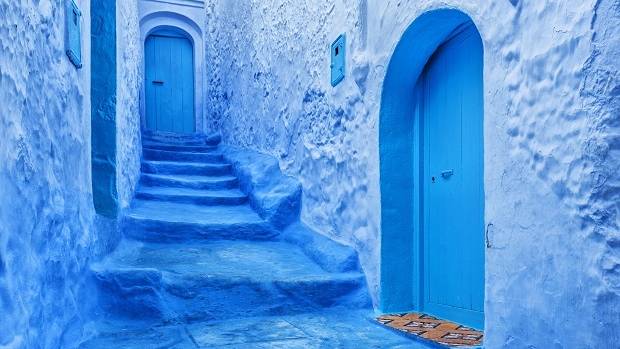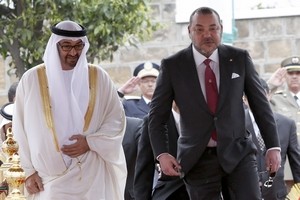NZ Herald
By: Courtney Whitaker
From azure to zaffire, the world of blue has a breathtaking home in Morocco’s ancient Rif Mountains, and it’s well worth the journey writes Courtney Whitaker.
The old man is walking slowly.
He’s holding a large, modern-looking backpack that doesn’t quite fit in with his traditional Moroccan djellaba and taqiyah (skullcap). He moves purposefully. He’s looking for something, and suddenly he sees it: tourists.
In a sudden, swift movement, the backpack is on the ground and the man is cradling a giant cobra. He’s patting it, talking to it as though it were a placid and much-loved pet puppy
“This cobra is 10 years old,” says the Moroccan guide of a group of horrified-looking American tourists. “It’s his pet.”
We are in Tangier, Europe’s gateway to Africa.
Tangier is a fascinating and diverse place, steeped in history and with its port sitting on the Strait of Gibraltar. The hillside city is a whitewashed mash-up of Spanish, Portuguese and Moorish architecture. It has a modern, pumping new town and traditional old medina with Petit and Grand Soccos (souks). From the main boulevard by the sea, Spain is visible through the haze in the distance, and the city is an easy, one-hour ferry ride from Tarifa.
But Spain can wait.
Today, we are heading much further inland into the Rif Mountains of Morocco.
Our driver assures us it’s an easy drive and that if we get there early enough we’ll avoid the large buses full of other tourists vying for a slice of our destination and that all-important Instagram selfie.
We’re bound for Chefchaouen: The Blue Pearl of Morocco.
This place has been on my wish list forever. I’m absolutely fascinated by it because it’s blue. All of it; walls, footpaths, doors. And I need to see it for myself.
But first: two hours in a car on a 40C day. We are lucky because, firstly, there is absolutely stunning scenery along the way, secondly, we have air-conditioning, and thirdly, our driver has persuasively promised to give the car hell to get us there in less than two hours.
The blue-washed mountain village we are headed for is nestled in the mountains, in an unassuming location that you’ll never just pass through. It requires a bit of planning if you wish to visit, and I’m hoping that our four-hour return day trip will be worth it.
But our little pilgrimage is not all about looks. Chefchaouen, like much of Morocco, is old.
Really old. Founded in 1471, the city has a bustling main square, Place Outa el Hammam, a 15th-century fortress and dungeon, and a museum. In 1920, Chefchaouen was seized by the Spanish, and returned to Morocco in 1956 during the Revolution of the King and the People — an independence negotiated by Sultan Mohammed V.
We are told conflicting stories as to why the city is blue, including one that it is to keep mosquitoes away. Although I like this theory, our driver tells us it is to symbolise the sky, or heaven. He believes it is blue for a spiritual reason.
Realistically, I don’t think our lovely driver was doing us a favour by driving fast. The open-road traffic laws in these parts don’t appear to … exist. Neither do indicators. He curses in Arabic as he whizzes round blind corners past slow cars packed with more people than there are seats.
I do my best to concentrate on the scenery. We drive through the pretty, whitewashed town of Tetouan, with its street-side vendors selling the traditional hat of the Jabala mountain people: a large woven hat with a wide brim and flamboyant pom-poms in hot pink and lime green. I really want one but there isn’t time to stop. We have a mission and we must continue on.
Before long we’ve reached the mountains and we’re speeding through a lush green area punctuated by roadside pottery shops, the odd chicken, small mosques and beautiful bougainvillea growing haphazardly over small mud-brick houses. It’s a beautiful area, sparsely populated and completely overgrown.
Much of the overgrowth looks to be the same plant. A familiar sort of plant. The sort not found growing so obviously back home and certainly one you wouldn’t want to be caught growing in your herb garden. Our driver brings his hand to his mouth holding an invisible cigarette and winks at us in the rear-vision mirror, confirming our suspicions.
Eventually, the landscape starts turning blue. Blue letterboxes, blue fences, blue cars even. We’ve arrived. Alive.
Our driver finds a spot in an impossibly tight carpark and promises to wait while we explore.
The Blue Pearl doesn’t disappoint. It is indeed blue; at least 50 shades of it.
It’s otherworldly, and if not for the smattering of tourists I would feel as though I was walking through a painting. Narrow streets are lined with shops selling hats, Berber carpets, pots of colourful powdered paints, scarves, leather goods. People hang their laundry from the windows of their homes to dry, and even their clothing seems to be in perfect harmony with the hue of the walls. I imagine this place — its old stone walls, arches and Moorish doorways — is still similar to how it was hundreds of years ago.
We find ourselves going further and further into the powder-blue jungle. Round corners, up alleyways, through low-hanging arches, past doorways lined with intricate mosaics and up stairs; every turn reveals a new wonder.
People do live here though, it is home to more than 42,000 and I start to feel disconcerted when I see tourists peering into people’s homes and photographing the local children. I can’t help but wonder what the locals think of their home being such a spectacle. Tourism brings a lot of economic good to this region, but at what expense?
Perhaps these humble, gracious people are more than happy to share their picturesque home with visitors. The smiles on their faces would certainly suggest so.
It’s hitting 43C, I can feel my face turning the colour of the local bougainvillea. I’m dying for a cool glass of something, so we head back outside the old city walls in search of a cafe or bar to gather our thoughts.
Our driver is waiting as promised. He is holding three large bottles of water and some locally made goat’s cheese, which he gives us, and tells us is the best goat’s cheese in Morocco. There is also an area nearby, he says, where you can get the purest water from a natural mountain spring, and offers to take us there on our way back to Tangier.
We drive towards the spring and arrive to find it and the river it feeds completely overrun by tourists trying to get at the cool water, and locals bathing in the river to combat the intense heat.
We decide to return to Tangier minus the spring water but stop at a lookout on the way out of the city to get a fuller picture of the area.
From here, we get the most breathtaking panorama of Chefchaouen in all its glory. Blue-washed mud houses stretch for miles with the Rif Mountains rising majestically above the city. This is hundreds of years of history just nestled into a hillside.
This is what I came for.
Checklist
GETTING THERE
Qatar Airways flies from Auckland to Casablanca, via Doha, with connecting onward flights to Tangier. Return Economy Class fares from $1614.
TOP TIP
Unless you are travelling with a tour group or by coach, the most convenient way to get to Chefchaouen from Tangier is by private car. Most taxi drivers will be happy to take you there, but you should agree to a set price before you leave. The trip takes just over two hours each way and a round trip should set you back approximately $200.






